Section 1 — Conduct of Vessels in any Condition of Visibility Rule 5 : Look-out Every vessel shall at all times maintain a proper look-out by sight and hearing as by all available means appropriate in the prevailing circumstances and conditions so as to make a full appraisal of the situation and of the risk of collision.Meaning: Lookout is very important and should take about 70 - 80% of the watch keeping officers time. The rest is to be the full appraisal of what he sees, and the action that is taken by him. Lookout is also for getting the feedback on the action that he or the other … [Read more...]
Rule 4 – Application
Section 1 — Conduct of Vessels in any Condition of Visibility Rule 4 : Application Rules in this section apply in any condition of visibility.Meaning: The above section applies to all vessels and under any condition of visibility that is good visibility as well as when under poor visibility whatever the cause may be. … [Read more...]
Rule 3 – General Definitions
For the purpose of these Rules except where the context otherwise requires:a. The world “vessel” includes every description of watercraft including non-displacement craft, WIG craft and seaplanes used or capable of being used as a means of transportation on water.Meaning: All types of craft that float on water and are used as a means of transportation. Also included are crafts, which do not displace water - such as hovercraft. A seaplane when on the water displaces water so as long as it is on the surface of the water it is considered as a vessel. All barges are also included since no … [Read more...]
Rule 2 – Responsibility
(a) Nothing in these Rules shall exonerate any vessel or the owner, master or crew thereof, from the consequences of any neglect to comply with these Rules or of the neglect of any precaution, which may be required by the ordinary practice of seamen, or by the special circumstances of the case.Meaning: There is no escaping the penalty of not following these rules. Everybody is responsible and no excuses are permitted that ‘I forgot’ etc. Also, there are some practices which are followed by seamen which may not be in the rules but they have been said and in use for many years, even these … [Read more...]
Rule 1 – Application
a. These Rules shall apply to all vessels upon the high seas and in all waters connected therewith navigable by seagoing vessels.Meaning: All ships big or small are to follow the rules as given in Colregs. Small yachts, fishing vessels, and other barges all - as long as they sail on the seas. All waters connected to the high seas which include major rivers, having ports on their banks and which are visited by sea-going vessels. 'High Seas' means open seas, coastal waters or waters far away from land. All bays, and canals which are connected to the seas provided that they are sailed on by … [Read more...]
Convention on the International Regulations for Preventing Collisions at Sea, 1972 (COLREGs)
The 1972 Convention was designed to update and replace the Collision Regulations of 1960 which were adopted at the same time as the 1960 SOLAS Convention. Technical provisions The COLREGs include 41 rules divided into Six Sections:Part A - GeneralPart B - Steering and SailingPart C - Lights and ShapesPart D - Sound and Light signalsPart E - ExemptionsPart F - Verification of compliance with the provisions of the ConventionThere are also four Annexes containing technical requirements concerning lights and shapes and their positioning; sound signaling appliances; … [Read more...]


